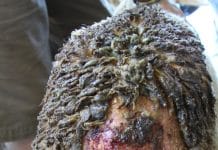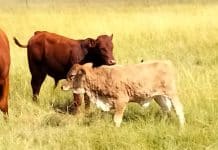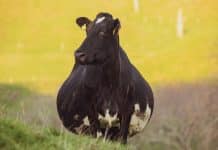Estimated reading time: 6 minutes
South African Boer goats have proven popular worldwide for their ability to improve indigenous goat breeds. In addition, Covid-19 restrictions necessitated the establishment of electronic auctions, making it easier for foreigners to acquire outstanding genetic material exported by agents via established channels.
Meticulous management systems enable the Boer goats of the Shongololo Stud near Loskop Dam in Groblersdal, to overcome a restrictive environment and produce according to their genetic potential. Only genetically superior breeding animals are used and those unable to perform in this environment are culled.
Selecting for an excellent flock
At the end of 2018, Fouchè and Franscois discussed the future of the Boer goat flock as a sustainable and profitable business. They decided that, as with Fouchè’s game enterprise, outstanding genetic material was the only way to accomplish this.

They went in search of the best breeding material and purchased an entire stud, which by 2020 had grown to 1 200 Boer goats. These animals were thoroughly examined, and they decided that traits such as birthweight, weaning weight, post-weaning growth, fertility and the ability to yield multiples needed improving.
The ewes in the flock were far from inferior, but to enhance these traits even further only the best 700 animals were retained. The plan was to achieve their breeding goal within three years.
Once the ewes were in place, the search was on to find the top Boer goat rams for the Shongololo Stud. Eventually they settled on the world champion six-tooth ram, Fanbelt, and a ram that placed third during the same round of judging, Conveyor. These bloodlines, along with strict selection, make for very sought-after breeding animals.
Each day is a learning curve
The saying goes that to measure is to know. Fouchè and Franscois, however, have their own version: We know that we don’t know. This is why they make use of experts for advice regarding selection, grazing, supplementation and health.
Franscois says they initially struggled to obtain the correct supplements to support optimal performance. While the summer grazing is lush and nutritious, its nutritional value decreases sharply in winter. Today they have supplements for each season and production stage. Combined with excellent genetic breeding material, this allows for optimal production.
They were able to increase lambs’ birthweights by an average of around 25% – 4,2 to 5,2kg for single lambs, 3,8 to 4,4kg for twins and 2,8 to 3,2kg for triplets. These weights make for vigorous lambs and no lambing problems. Lamb mortality was also reduced from 9 to 2%.
In order to promote fertility, they try to use more breeding animals that came from multiple births. Although Boer goat ewes are able to lamb three times every two years, a single lambing period per year has proven satisfactory. This puts less stress on ewes and prolongs their productive life by up to three years.
Breeding and lamb rearing
They run two mating seasons: the first in April and May, and the second in October and November. Around 80% of the ewes are artificially inseminated with semen from rams that are carefully selected according to their pedigrees. Not only does this improve the traits they are aiming for; it also promotes corrective breeding so as to enhance economically important traits. Only the young ewes are mated naturally.
Ewes are synchronised in a way that allows them to inseminate 100 ewes simultaneously every two weeks, thus alleviating the pressure come lambing time. This system allows for meticulous breeding and quicker genetic progress while using fewer but better rams. Ewes are scanned after 46 days to identify those carrying multiples and to adjust their nutrition accordingly.
Ewes lamb in lambing pens where they can be closely monitored. Once the lambs are strong enough, the ewes are sent to the veld during the day while the lambs remain in the pens. Lambs are given creep feed from day seven. Because they are left behind in the pen and cannot suckle, they learn to eat much sooner, which reduces weaning shock.
Lambs are weaned at 100 days. At this stage the single lambs weigh around 21 to 28kg. Some of the outlier lambs weigh up to 32kg. Lambs that are part of multiples are usually 10% lighter. The weaning percentage is normally above 95%. Up until weaning, lambs are weighed every week to monitor their growth. This information is added to the comprehensive set of data utilised during selection.
After weaning, lambs are sent to the feedlot for 100 days to grow out. Afterwards, they undergo the first round of selection and are sent to the veld until they are eleven months old. They are then subjected to the final round of selection. During this process replacement animals are selected and animals are identified for their production auction. Those that don’t make the cut go to the commercial herd.
A unique grazing system
Grazing camps on the farm are somewhat unique in that three metre long movable gates are used to camp off areas 30 to 60ha in size. High-density grazing is then applied using 200 to 300 animals that graze the area short. This simplifies the task of moving the animals to the kraal at night to eliminate predator strikes.

Two workers are able to build the camps within four to six days. This system forces the goats to make full use of the grazing. At the same time, it reduces bush encroachment and creates firebreaks.
Going from strength to strength
This year the Shongololo Boer Goat Stud did extremely well when they presented 40 ewes and 15 rams at the Befonk Boer Goat auction, along with well-known breeder Lukas Burger. One of their animals fetched R125 000, the most expensive ewe auctioned on the day, and one of their rams sold for R140 000. Lukas sold the most expensive ram for R275 000.
Fouchѐ and Franscois say the demand for breeding and slaughter Boer goats far exceeds what breeders can supply. The export market has expanded by leaps and bounds over the last year or so, and electronic auctions did a lot to boost the Boer goat market even further. – Andries Gouws, Stockfarm
For more information, contact Fouchѐ Blignaut on 082 492 7388 or foucheb@ctecg.co.za, or Franscois Bouwer on 082 924 9419 or fjbouwer@gmail.com.









